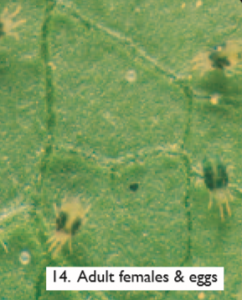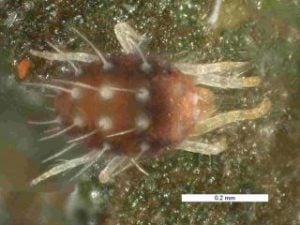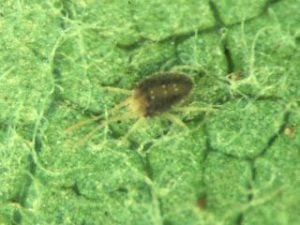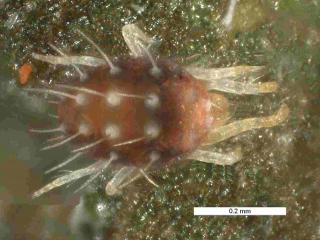Monitoring mites
Late November is the time to start monitoring for Two-spotted, European red and Bryobia mites. Although fortnightly monitoring is usually sufficient unless numbers are approaching the action threshold, the use of random sampling in weekly monitoring allows you to cover a greater spread of the orchard and increases the reliability of your results.
Mites, as a group, can develop pesticide resistance quickly. To help prevent resistance it is important to use pesticides in a sustainable manner, that is:
- Regularly monitor orchards and only apply pesticides when pest mites are present above threshold levels
- Preferentially use pesticides that have minimal impact on beneficials
- Rotate between miticides from different groups/with different modes of action
- Always follow label instructions
You can monitor for all mites, pests and predators, at the same time. Before heading out to the orchard familiarise yourself with what the various mite species look like, plan which block you will monitor and take a 10x hand lens and something to record what you find. In most cases it is more efficient to combine monitoring for mites with monitoring for other pests, diseases and weeds. See IPDM Monitoring Calendar; IPDM Monitoring Sheet; and Factsheet: Monitoring the populations of pests and diseases.

Two-spotted mite adult female and eggs (Photo: AgVic)

European red mite adult female (Photo: DPIRD WA)

Bryobia adult mite (Photo: DPIRD WA)
There are conflicting methods for monitoring mite populations in orchards. Some consultants prefer to take 2 leaves from 25 randomly selected trees within a block. Another recommendation is to select 5 leaves from 10 randomly selected trees. In Victoria, the standard is to randomly select 5 trees and sample 10 leaves from each of those trees. In all cases a total sample of 50 leaves is taken from the block. If Two-spotted mite (TSM) is the major pest the leaves should be taken from the bottom third and centre of the tree, as this is where you’re likely to first find them. For European red mite and Bryobia mite the infestation starts from eggs laid around spurs on the branches and therefore these mites are distributed higher and further out from the centre of the tree.
There’s no need to count every mite just take note of the presence or absence of the pests and the predatory mites.
Mite threshold levels
The thresholds vary between apples and pears, and for different varieties. Spray thresholds published in the late 1970s and 1980s for pears were 30-40% of leaves with pest mites, and for apples up to 90% of leaves with pest mites before chemical intervention is recommended. For two-spotted mite in apples the recommended thresholds were adjusted to account for the activity of predatory mites:
- if less than 45 leaves (90%) are infested by active stages of Two-spotted mite, a miticide application is not required.
- if more than 45 leaves (90%) are infested by Two-spotted mites and less than 35 leaves (70%) have active stages of predators (this includes small and, adult predators), apply a miticide or consider predator release
- if more than 45 leaves (90%) are infested by Two-spotted mite and more than 35 (70%) have active stages of predators, a miticide is not required because control of Two-spotted mite by the predator should occur within two weeks.
More recent studies demonstrated that the most important factor for mite damage was a combination of the percentage of leaves infested and how long the leaves were infested. The conversion of percentage leaves infested to cumulative leaf-infested days provides a better way of predicting when thresholds will be reached and allows for the activity of predators against the mites.
Reduce chemical use
The reliance on chemical control can be further reduced by management options that help prevent pest outbreaks and encourage beneficials. These include:
- Maintain healthy trees through good irrigation and nutrient management – they can tolerate mite populations more than stressed of weakened trees.
- Reduce dust – mite infestations are worse on dusty trees.
- Apply oil sprays just prior to European red mite or Bryobia mite egg hatch – this is the stage at which the eggs are most susceptible.
Note that one of the main predators of European red mite in eastern Australia, Galendromus (=Typhlodromus) pyri, is not present in Western Australia. Galendromus (=Typhlodromus) occidentalis is present and does feed on Two-spotted mite but is not as effective on European red mite.
Further information links
https://www.agric.wa.gov.au/pome-fruit/miticides-wa-deciduous-fruit-trees?nopaging=1
https://www.agric.wa.gov.au/pome-fruit/management-european-red-mite-western-australia
Article reviewed by David Williams (Agriculture Victoria) and Dr Stephen Quarrell (Tasmanian Institute of Agriculture)

